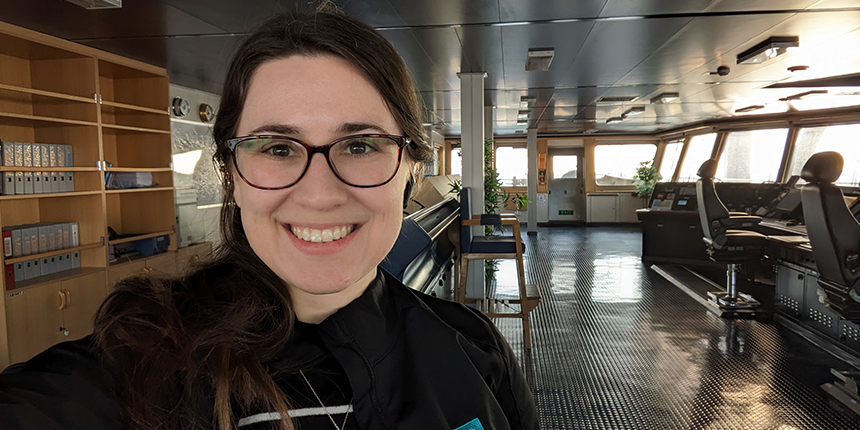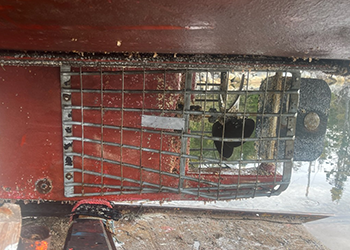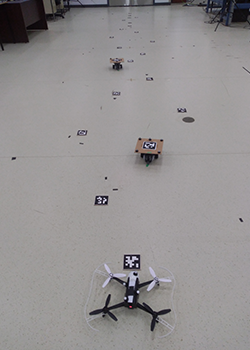
From noisy seas to whale strikes to navigation systems, autonomous systems engineer Amy Deeb, P.Eng., breaks down problems to their base components to build innovative solutions.

What do small fishing vessels battling noise problems, the probability of a ship encountering a whale, and an autonomous underwater vehicle (AUV) navigating through ice have in common? Amy Deeb, P.Eng., an autonomous systems engineer in Nova Scotia, has tackled each challenge using her engineering skills, innovation, and knowledge of autonomous systems to bring practical solutions to real-world problems.
Deeb has made a career out of using autonomous systems to solve broad, complex problems, by searching for patterns within the data and reducing them down to the simplest terms where the solution can be found. Autonomous systems are uniquely suited not only for collecting data but also for sorting through large numbers of variables to find hidden patterns that can lead to breakthrough solutions.
Seeing through all the noise
Due to human activity, the ocean is becoming very loud, with low-frequency noise levels having more than doubled each decade since 1950. This noise has a huge impact on marinelife and can consequently affect ocean industries like fishing.
One of Deeb’s most rewarding projects involved working directly with fishermen on the East Coast who use Cape Islander vessels. “This was a really fun one for me because of the direct impact. We spoke with the fishermen about how their vessels’ performance affects their livelihoods and, in particular, how they could feel the noise; they knew these things intuitively from experience and we could back it up with data,” Deeb explained. Noise from ships can cause marine life to shift their habitats, changing the fishing grounds. While large ships produce more noise than smaller vessels, if several fishermen are working persistently in the same region, the impact can grow.

Deeb and her team used hydrophones, essentially underwater microphones, to gather data off the coast of Nova Scotia, near Peggy’s Cove. “One of the challenges with underwater radiating noise is that we’re not just concerned with the volume. The pitch of the noise influences what’s harmful,” Deeb explained. The noise spectrum is affected by many factors such as the vessel’s shape, materials, and operating speed; there are also environmental factors that affect the sound such as the water depth, temperature, and overall environment. These were all factors that had to be considered in order to look for patterns, limit the number of parameters, and determine the biggest impacts. “To model that, it's easier to use artificial intelligence and machine learning techniques because there's a huge variety of factors and it's hard to build a physics-based model that can define how the noise goes from the vessel into the water,” Deeb explained.
The information was taken back to the fishermen directly. Deeb and her team identified differences in noise between different engine speeds and when the vessels’ hulls were clean versus fouled among other factors. This project took into account the equipment the fishers use, how they work, and ways in which they could change their volume that suited their abilities and needs, with the aim of providing them with practical and actionable information.
Predicting motion
In the Cape Islander case, the team was focused on modelling the source of underwater noise to help vessel operators identify noise reduction solutions. When working on a separate project, they switched perspectives to modelling the marine mammals impacted by the underwater noise.
The Scotian Shelf, located southwest of Nova Scotia, is home to a number of whale species throughout the year, who are at risk of being struck by large vessels or being affected by loud noises. Commercial shipping vessels, cruise ships, at-sea construction teams and others need to understand the level of risk they are posing to whales and how that risk changes. Deeb applied a probabilistic model to biological systems, looking at likelihood of encountering whales. For a problem like this, the likelihood of a strike is low, but the impact of such an event can be catastrophic. “If we can model that well and understand how that risk is changing over time then we can determine what actions should be taken,” Deeb explained.

The whales’ movements vary by season, determining how long they stay, what activities they do, how often they come to surface, and much more. “The beauty of a probabilistic model is that it looks very simple on paper; the likelihood of a whale being present is a ‘four-term’ kind of solution. But how to model each of those terms is extremely complex and requires a huge amount of data that we just don't have yet,” Deeb said.
Deeb’s work provided more information on the type and breadth of data that still needs to be collected in order to properly predict how and when whales are moving.
The idea to model the whale movements probabilistically came from Deeb’s area of focus during her Ph.D., simultaneous localization and mapping, also known as SLAM.
SLAM allows an autonomous vehicle to figure out where it is in the world without a map. In deep water, an AUV can’t use GPS to determine where it is. How does it localize, to know where it is and where it needs to go? One answer is to find landmarks such as notable features on the sea floor and base where it is by tracking its motion in relation to those landmarks. For her Ph.D., Deeb considered an aerial vehicle in the Canadian Arctic where GPS can be unreliable. There, the main landmarks are ice floes, which are generally not static. They move about. So, what do you do when your landmarks are also moving?
Deeb’s solution uses observations of an ice floe’s past movements to predict its location. In their own way, they move very consistently, making it possible to include their motion in the probabilistic model. “Once you break down that motion to something logical, you build that into your model, and you keep going,” Deeb said. The challenge is figuring out what part of the problem the system needs to respond to—and having enough information to respond properly.
Safeguarding future technology
Lloyd’s Register, where Deeb works, has over two centuries of history and experience working in marine technology. One of their main goals is “engineering a safer world,” a goal that resonates strongly with Deeb. “They're making a real contribution to how we think about risk and how we think about having the right capabilities to safeguard people, the environment, and our systems for the future. Hopefully what I'm doing is contributing in small ways to that.” Deeb said.
One of the best parts of her job, she adds, is that Lloyd’s Register actively encourages their engineers to think decades ahead, consider what the biggest challenges might be, and what guidelines they will need to have in place to safeguard against possible risks. This makes her job uniquely suited to considering the implications of large-scale digital systems.
Part of the issue is making sure that the new digital technology that is developed will solve actual problems that people face and won’t create new, unforeseen problems. “Systems that are developed with a strong understanding of where they should be used and where they should not be used... those systems are so much more effective,” Deeb says.
For digital systems, it’s harder to make it apparent to the user how the system should not be used. And confounding that problem is the sheer scale on which digital systems are deployed. “Humans really understand a certain scale of size...and I think we've got an intuition for the environments that we impact. But when we start operating with digital systems that affect millions of people, with systems that we can get distributed across a huge variety of use cases, we lose track of some of the details of working at that scale.” To Deeb, “scalability is going to be a really big challenge facing engineers.”
Transferable solutions
Every day is a new adventure for Deeb. “Every time that you've got an idea, I think there's an opportunity to think about how that could help somebody in a different way than you ever imagined.”
On some days, Deeb takes innovations like outer vessel coatings used to reduce drag and increase speed and determines if they can be used to reduce noise pollution. On other days she looks at how autonomous systems make decisions and provide information back to operators without overwhelming them with unnecessary data. Every time she goes to work, she considers how to make communication more efficient within autonomous systems and between the people who design those systems and the ones who use it.
In her own words, “engineering can be impossible to describe, with so many potential fields and jobs. The best way to truly understand what engineering is to you is to make it your own.”
Engineers build more than just bridges. Building Tomorrows is a series that highlights the important contributions of engineers and the many ways they help to make our world a better place.


